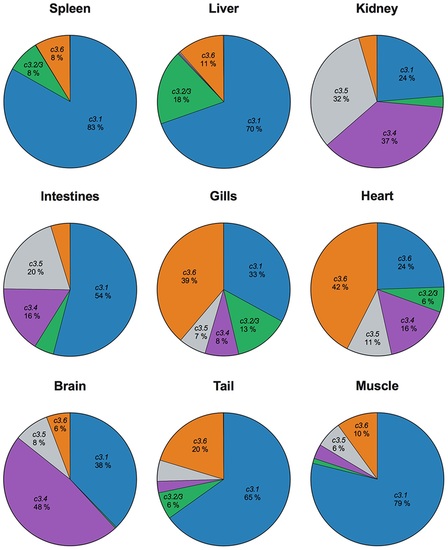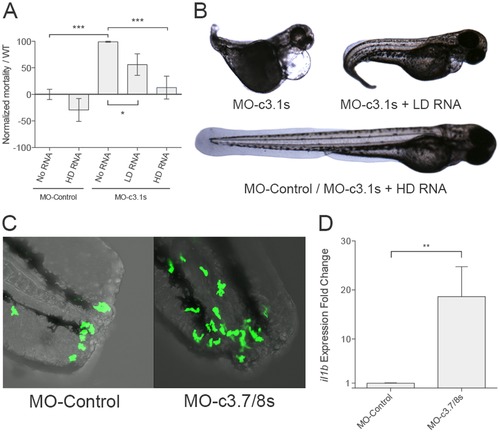- Title
-
The Evolution and Appearance of C3 Duplications in Fish Originate an Exclusive Teleost c3 Gene Form with Anti-Inflammatory Activity
- Authors
- Forn-Cuní, G., Reis, E.S., Dios, S., Posada, D., Lambris, J.D., Figueras, A., Novoa, B.
- Source
- Full text @ PLoS One
|
Basal expression of c3 in adult zebrafish tissues. c3.1, c3.2/3, c3.4, c3.5, c3.6 and c3.7/8 mRNA expression was evaluated in different adult zebrafish tissues. c3.7/8 was not represented in the graphics due to its low expression in comparison to the other c3 genes. The graphs depict the mean results from 3 different experiments, each using a pool of 4 animals. |
|
c3 expression during development. (A) c3 expression was evaluated in zebrafish larvae over time. c3 expression values were normalized against the expression of elongation factor 1-α. The graph depicts the mean results from 3 different experiments, each using a pool of 10–15 (3 hpf to 14 dpf) or 6–8 (17 dpf to 29 dpf) animals. (B) c3 expression relationships between the adult and larval stages. c3 expression values from adult individuals were divided by the mean values obtained during larval ontogeny. (C). In situ hybridization of a 5 dpf zebrafish larvae showing primary c3.1 expression in the liver. EXPRESSION / LABELING:
|
|
Zebrafish c3 inhibition results in differential abilities to induce neutrophil migration. The tails of Tg(mpx:GFP) zebrafish were amputated from 3 dpf individuals in which the c3.1-2/3-6 or c3.7/8 had been inhibited with the MO-ATG-c3u or MO-ATG-c3.7/8 morpholinos, respectively, and were visualized after 24 h. (A) Relative fluorescence intensities in the amputated zones were calculated with ImageJ (arbitrary units). N = 20 animals per group. Statistical significance was determined by unpaired T-tests (**P<0.01). (B) Fluorescence microscopy images of the treated phenotypes show differential neutrophil migration activities. The figure depicts a representative of 3 experiments. PHENOTYPE:
|
|
Developmental and inflammatory effects of the c3.1 and c3.7/8 inhibition. (A) MO-c3.1s injected at high concentrations produced aberrant phenotypes and increased mortality. Co-injecting with c3.1 capped mRNA recovered the WT phenotype in a dose-dependent manner (LD: 2,25 ng c3.1 capped RNA; HD: 4,5 ng c3.1 capped RNA). (B) Representative individuals of the c3.1 inhibition treatments and its phenotypic rescue. (C) MO-c3.7/8s microinjected larvae showed a major migration number of neutrophils to the amputation site 3 h after tail clipping (confocal images). Statistical significance was determined by unpaired T-tests (**P<0.01, ***P<0.001). (D) MO-c3.7/8s microinjected larvae significantly expressed higher levels of il1b 3 h after bath infection with A. hydrophila. |

Unillustrated author statements |




